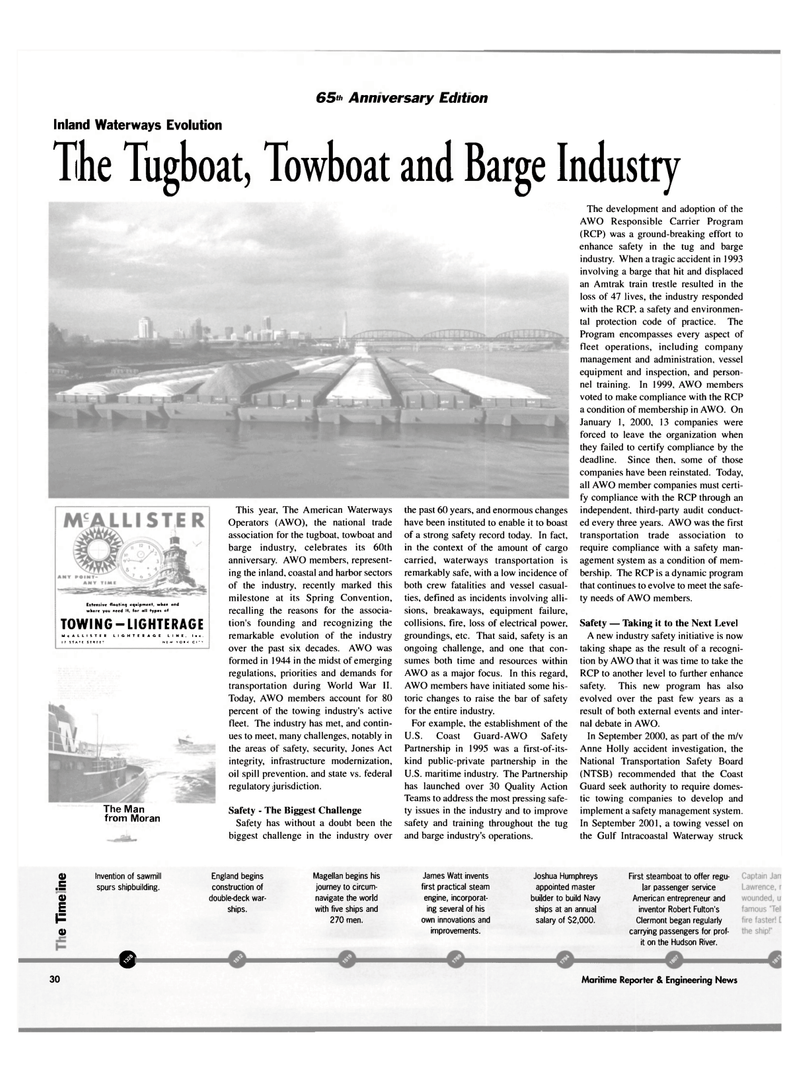
Page 30: of Maritime Reporter Magazine (August 2004)
65th Anniversary Edition
Read this page in Pdf, Flash or Html5 edition of August 2004 Maritime Reporter Magazine
65"' Anniversary Edition
The Tugboat, Towboat and Barge Industry
Inland Waterways Evolution
Extensive floating equipment, when and where you need it, for all types of
TOWING-LIGHTERAGE
MCALLISTER LIGHTERAGE LINE. inc. 17 STATE STREET NEW YORK CITY
The Man from Moran
This year. The American Waterways
Operators (AWO), the national trade association for the tugboat, towboat and barge industry, celebrates its 60th anniversary. AWO members, represent- ing the inland, coastal and harbor sectors of the industry, recently marked this milestone at its Spring Convention, recalling the reasons for the associa- tion's founding and recognizing the remarkable evolution of the industry over the past six decades. AWO was formed in 1944 in the midst of emerging regulations, priorities and demands for transportation during World War II.
Today, AWO members account for 80 percent of the towing industry's active fleet. The industry has met, and contin- ues to meet, many challenges, notably in the areas of safety, security, Jones Act integrity, infrastructure modernization, oil spill prevention, and state vs. federal regulatory jurisdiction.
Safety - The Biggest Challenge
Safety has without a doubt been the biggest challenge in the industry over the past 60 years, and enormous changes have been instituted to enable it to boast of a strong safety record today. In fact, in the context of the amount of cargo carried, waterways transportation is remarkably safe, with a low incidence of both crew fatalities and vessel casual- ties, defined as incidents involving alli- sions, breakaways, equipment failure, collisions, fire, loss of electrical power, groundings, etc. That said, safety is an ongoing challenge, and one that con- sumes both time and resources within
AWO as a major focus. In this regard,
AWO members have initiated some his- toric changes to raise the bar of safety for the entire industry.
For example, the establishment of the
U.S. Coast Guard-AWO Safety
Partnership in 1995 was a first-of-its- kind public-private partnership in the
U.S. maritime industry. The Partnership has launched over 30 Quality Action
Teams to address the most pressing safe- ty issues in the industry and to improve safety and training throughout the tug and barge industry's operations.
The development and adoption of the
AWO Responsible Carrier Program (RCP) was a ground-breaking effort to enhance safety in the tug and barge industry. When a tragic accident in 1993 involving a barge that hit and displaced an Amtrak train trestle resulted in the loss of 47 lives, the industry responded with the RCP. a safety and environmen- tal protection code of practice. The
Program encompasses every aspect of fleet operations, including company management and administration, vessel equipment and inspection, and person- nel training. In 1999, AWO members voted to make compliance with the RCP a condition of membership in AWO. On
January 1, 2000, 13 companies were forced to leave the organization when they failed to certify compliance by the deadline. Since then, some of those companies have been reinstated. Today, all AWO member companies must certi- fy compliance with the RCP through an independent, third-party audit conduct- ed every three years. AWO was the first transportation trade association to require compliance with a safety man- agement system as a condition of mem- bership. The RCP is a dynamic program that continues to evolve to meet the safe- ty needs of AWO members.
Safety — Taking it to the Next Level
A new industry safety initiative is now taking shape as the result of a recogni- tion by AWO that it was time to take the
RCP to another level to further enhance safety. This new program has also evolved over the past few years as a result of both external events and inter- nal debate in AWO.
In September 2000, as part of the m/v
Anne Holly accident investigation, the
National Transportation Safety Board (NTSB) recommended that the Coast
Guard seek authority to require domes- tic towing companies to develop and implement a safety management system.
In September 2001, a towing vessel on the Gulf Intracoastal Waterway struck 0) c • — 0) E 1= 0)
Invention of sawmill spurs shipbuilding. .0.
England begins construction of double-deck war- ships.
Magellan begins his journey to circum- navigate the world with five ships and 270 men.
James Watt invents first practical steam engine, incorporat- ing several of his own innovations and improvements.
Joshua Humphreys appointed master builder to build Navy ships at an annual salary of $2,000.
First steamboat to offer regu- lar passenger service
American entrepreneur and inventor Robert Fulton's
Clermont began regularly carrying passengers for prof- it on the Hudson River. 30 Maritime Reporter & Engineering News

 29
29

 31
31
